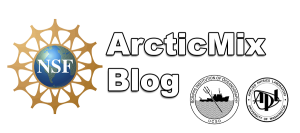Arctic Mix // Media Release
Oceanographic team finds new clues to the ocean’s heat driving Arctic’s fourth lowest sea-ice minimum
September 15th, 2015 – R/V Sikuliaq, Beaufort Sea
Today, as the National Snow and Ice Data Center (NSIDC) announced the fourth lowest Arctic sea-ice minimum on record, an oceanographic team aboard the National Science Foundation’s R/V Sikuliaq is using unique instruments to explore the undersea secrets of ice-melt in the Beaufort Sea. The ‘ArcticMix’ voyage leaders from UCSD’s Scripps Institution of Oceanography and University of Washington’s Applied Physics Lab are surprised by the strength of ocean mixing they have observed in their raw data. Their findings, while preliminary, may change our understanding of the impact of climate change in the Arctic.
“The ArcticMix voyage is right on top of what the NSIDC has called ‘a striking feature of the late 2015 melt season’,” said Scripps Institution of Oceanography’s Dr. Jennifer MacKinnon, chief scientist aboard the R/V Sikuliaq.
“Our instruments are seeing billows of turbulence that look just like a wave breaking on the beach, but much larger.
“As a result, heat is being mixed up towards the surface, and the remaining ice, at a remarkable rate.
“While we hypothesised this might be happening, we have been genuinely thunderstruck by how incredibly strong the turbulence is below the surface.
“This heat is likely playing a substantial role in the melting of the ice that we can see all around us, growing thinner every day, and our job now is to distinguish summer melting from longer term change.
Dr. Matthew Alford, also from Scripps, explains the peculiar nature of the Arctic that makes this possible.
“One of the unusual things about the Arctic is that it’s an up-side down version of the normal ocean, in that the surface water is cold and fresh,” said Dr. Alford.
“Below that there is a lurking mass of warmer, saltier water, heavier than the surface layer due to its high salt content.
“One hypothesis for a rapidly-changing Arctic is increasing open water allows storms to mix this deeper ocean heat upward through the generation of undersea beams of energy called ‘internal waves’, in turn melting more ice.
“The marked energetic mixing we are seeing here at the heart of the Arctic ice-melt zone may prove key in understanding a potential new climate feedback,” Dr. Alford concluded.
Dr. John Mickett, from the University of Washington’s Applied Physics Lab where the unique oceanographic tools used to measure Arctic mixing were developed, describes the challenges of working in the Beaufort Sea.
“Our expedition is the first time these tools have been used in these waters and we have an outstanding opportunity to observe Arctic change,” said Dr. Mickett.
“Aside from the obvious science challenges of working in the Arctic, with extreme cold and adrift ice-chunks that are unfriendly to sensitive instruments, we are out here trying to sample and describe a moving target.
“The Arctic Ocean is changing quickly and past studies describing the dominant processes and general oceanography of the region may now be inaccurate or even obsolete,” Dr. Mickett concluded.
“It’s really incredibly exciting to be catching this Arctic ocean mixing in the act,” Dr. Mackinnon continued.
“The trick now will be to carefully untangle the complex processes involved, with the hope of providing new insights that will help improve the accuracy of climate forecasts for the Arctic region,” Dr. Mackinnon concluded.
The ArcticMix voyage aboard the R/V Sikuliaq is funded by the National Science Foundation and includes over 20 scientists, students, and technical staff from UCSD’s Scripps Institution of Oceanography, University of Washington’s Applied Physics Lab, University of Alaska Fairbanks, MIT, Laboratoire de Physique, Lyon, and the University of Bergen.
ENDS
Arctic Mix Media Contact:
Thomas Moore, aboard the R/V Sikuliaq > thomas.surman.moore@gmail.com
More information
Blog: http://arcticmix.ucsd.edu
Images & Video: High-resolution images and video from Arctic operations are available on request. Interviews: can be arranged with the scientists aboard R/V Sikuliaq via email or sat-phone

